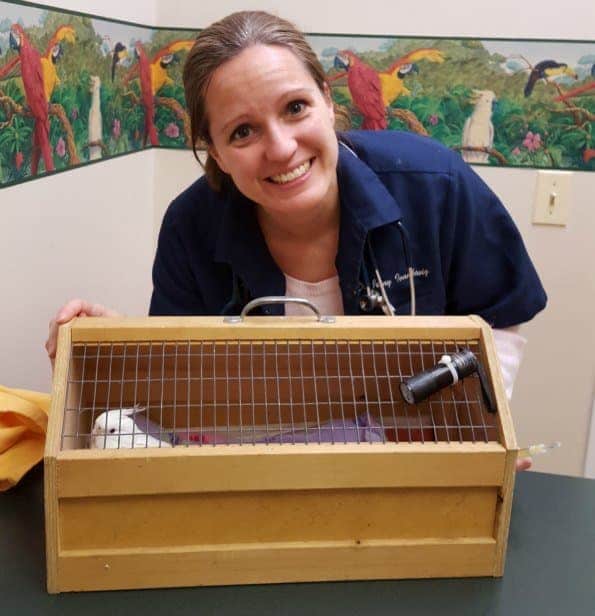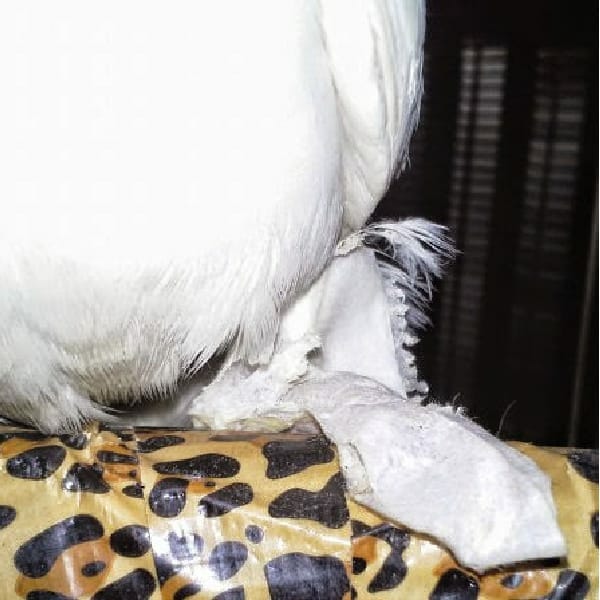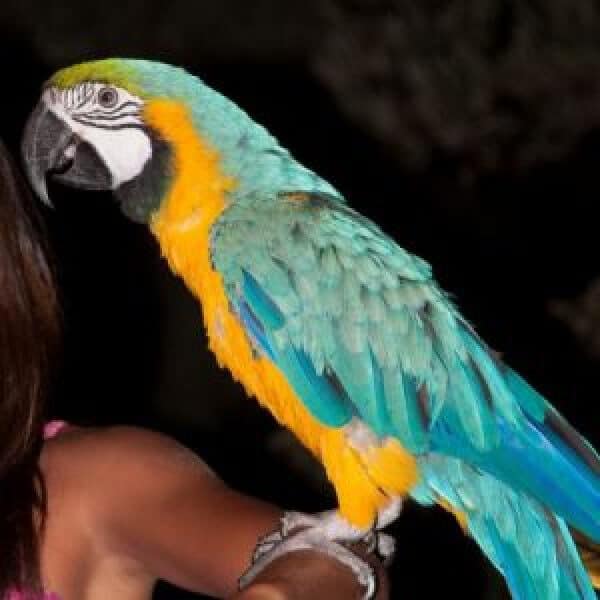Last Updated on by Mitch Rezman
Funny you should ask – file under life imitating art imitating life.
On the heels (<- pun) of last week’s blog entitled “How do birds sleep standing on one leg?” where we saw the most exceptional illustrations of how the flexor tendons in a birds leg act as an ingenious pulley system enabling a bird to firmly grasp a perch even while sleeping and in the case of birds of prey this system also aids in the killing of said prey.
Mother nature as usual was simple eloquent and right to the point. The question arose recently, for us, how do you shut down 50% of that system for maintenance? It’s been an interesting few days.
Last Friday, Popcorn our cockatiel walks out of the cage with a distinct limp. We could see her favoring her left foot on the cage landing door so I went over to her cage and offered my hand. I could immediately feel as she perched on my index finger, the reflexive “lift” of her left foot signaling she was having what we thought at the time was a foot issue.
Feathered factoid: birds have a pharynx, not a larynx like many terrestrial mammals including humans. This means you can easily restrain even the biggest of birds by forming a circle with your thumb and forefinger around their neck (illustrated in the video below).
The design means the bird has no feeling of “being choked” when restrained around the throat Use this method for common caged bird maintenance like nail trimming and wing clipping to avoid getting bit.
Having all of the right tools we were confident that we could handle what we thought was a simple Popcorn splinter and everything would be hunky-dory. Catherine held her on a towel while restricting Popcorn’s right leg and I went to work.
Under magnification, I could see a small black dot so I said “aha – a splinter” dipped a sewing needle into alcohol, and simply rubbed out the evil substrate in just a few seconds confident we had saved the day.
For recovery, we felt the best course of action was to spray the foot with Vetercyn (which is a healing spray as safe as water but also kills bacteria on contact) in the morning and apply HealX Soother Plus Topical Cream in the evening to reduce inflammation and pain. The scary sliver episode would end in a day or two, like all sliver extractions.
Monday morning, cage light goes on, I uncover her, open the landing door of her cage and……… she’s still limping (fill in your own expletive), we had fixed nothing.
Monday evening – it’s 5° out. I really don’t want to take her outside. Catherine and I talk, check their website, and call. Animal House of Chicago is open until eight.
Tracy, Dr. Byron’s wife (and hospital manager) answers the phone and said “they could see us in an hour”. It’s 6 pm.
Earlier in the day, we brought in her wooden carrier box inside (from the porch) to warm up, just in case”.
Her metal travel cage would be too cold no matter what and we wanted to be prepared which we were for this very moment.
We stuffed her little and very unhappy butt into the wooden carrier, wrapped it with an electric flannel blanket, realized I didn’t have an extension cord long enough for the electric blanket to make it to the vets so we bundled the bird, wood & flannel into an IKEA bag and headed north on icebound California ave.
Animal House of Chicago has been treating our birds for more than a decade. The first time I met Dr. Byron he was doing intake on a gecko. They do the two things that you want your vet to do, help keep your bird or pet healthy and fix it when it’s ill. Dr. Byron was playing Mr. Mom and so we were fortunate enough to get Dr. Ellen.
Dr. Ellen Boyd went to veterinary school at the University of Tennessee in Knoxville, where she was able to focus on exotic animal medicine and wildlife.
She completed an internship at the Audubon Zoo’s Center for Research of Endangered Species in New Orleans and stayed for two additional years as an associate veterinarian.
She began her reproductive research with cranes and really began to love working with birds.
Dr. Boyd continued working with migratory birds and earned a Ph.D. degree in 2007 from the University of Washington in Seattle doing fieldwork all over the West Coast and the Arctic Circle. Her dissertation focused on avian endocrinology and reproduction.
Before joining the Animal House of Chicago team in 2014, Dr. Boyd worked in shelter medicine at Paws Chicago and as a relief veterinarian at many animal hospitals in the greater Chicago area.
Her main interests are exotic animal medicine, general surgery, and shelter medicine. Dr. Boyd feels very fortunate to have had the opportunity to work with animals as companions and in their natural habitats.
Once inside the patient waiting room, it was time to unravel the feathers from the flannel, and that was one happy little white bird hopping out of the carrier. Michelle our tech came to do some initial intake and ask questions. She left and we waited for the doc.

Popcorn “patiently” (<-pun) waiting to meet Dr. Ellen.
The sound of Dr. Ellen’s hand touching the outside of our little room prompted Popcorn to fly up on my left shoulder. As Dr. Ellen and I chatted discussing the events described above, Popcorn, sore leg and all was making a large arc across my back eventually ending up on my right shoulder putting her just a little farther away from Dr. Ellen.
The moment came when Dr. Ellen scooped up Popcorn in a light towel and went to work. We agreed an x-ray was in order to play it safe. When she returned it was a good news-bad news scenario.
Popcorn had no breaks or fractures according to the x-rays but she did have tenderness & swelling in her left hock.
Popcorn was placed in a paper tape cast, immobilizing 50% of the aforementioned pulley system – her left leg. This was part one of the treatment. She was also to be given .07 ml of meloxicam once daily by mouth.
Meloxicam is a nonsteroidal anti-inflammatory drug (NSAID). It’s in the same class of drugs as Naproxen which makes it birdy Alleve. And it doesn’t help make your bird resent you less for the mouth syringe invasion.
The good doctor then casually mentions that best practices dictate that we pull all of her perches out of her cage so as to reduce her desire to use the bad foot. “Sure doc, piece of cake” (I’m trying to keep my head from exploding here) Have you ever seen Popcorn’s cage? Mom & Dad after all do run the Birdie Boutique
It’s now somewhere a little after eight and I call Catherine to give her a heads up explaining the necessary modifications needed for Popcorn’s cage. Sometimes I think this woman has some sort of artifact that enables her to move beyond speeds mere humans can visually perceive.
Confident Popcorn’s care was in the best possible hands, we agreed to return in seven days. I went to the front desk to finish off the visit. I’ve blocked out the prices on the Animal house invoice (below) because I know how much all of you listen to me and I don’t want you taking a document into your veterinarian saying “this is what mitchr pays, I want to pay the same”.
The problem is like any other professional service, charges will vary with the relationship you have with your vet, the number of animals you have that they care for, and your geographical location. Speaking of which there is going to be a flock of avian veterinarians migrating to Paris in April, more about that in a minute.
The bill is highly detailed. It breaks things down basically into “parts and labor”. I’m also reminded of Michelle the technician who did the initial intake then reported to Dr.Ellen prior to the examination – a team effort.
The bill also lists prior treatments and her weight history something you know that we talk about a lot. Weighing your bird regularly is the cheapest health insurance for a bird that you can get. Sudden changes in weight will always be a red flag regarding your bird’s health.
In spite of being flighted and getting a lot of exercise, at 118 g she needs to drop some weight. It’s contributing to unneeded pressure on the leg joints according to Dr. Ellen. She’s stopped laying eggs so hopefully, her appetite will recede.
We feel bad about leaving her home in her cage all winter while we work but it’s just much too cold for her to travel daily. We’ve been rewarding her with more spray millet to help smooth over our shared guilt. Popcorn is officially off millet. Millet is to birds what McDonald’s French fries are to us – yummy & fattening.
It took much less time on the trip home. Popcorn’s cage new design would have made the writers of the “Americans With Disabilities Act” proud.
Now when we come home from the shop she’s able to climb the bars up to the top of the cage while shrieking displeasure at our earlier departure like an inmate grabbing the jail bars screaming “I’m innocent, I don’t deserve any of this”.
We couldn’t neutralize the entire house so we clipped 4 primary flight feathers about halfway down on both wings in the hopes of short-circuiting her flight paths. She must be really strong because her flight ability wasn’t hampered for a moment. How is she doing with all this you ask?
My guess is she saying to herself she is glad that she wasn’t born a duck because ducks have terrible, flat feet.
She is highly focused on removing the little paper cast
At the time of this writing, Thursday evening, Popcorn had chewed off much of the bandage and it was beginning to come undone.
After a brief phone consultation with Dr. Byron, we reapplied some fresh adhesive bandages in the form of a bandaid sandwich (the webfoot look) and hope it will last until next Tuesday – yeah right.
The aforementioned Paris thing:
You don’t walk into a lot of veterinarians’ offices and see that they treat all of the following species
|
|
|
|
As if that isn’t awesome enough turns out Dr. Byron and his wife Tracy will be traveling to an ICARE International Conference on Avian heRpetological and Exotic mammal medicine conference in Paris France this April.
I discovered that Dr. Byron is the chairman of Pharmacology-Clinical pathology for the conference. He will be also conducting Masterclasses in Herpetology covering current advances in reptile +/- amphibian clinical/diagnostic & therapeutic techniques in the lab.
But wait there’s more! It’s their 20th anniversary. And guess where they got married? In Paris. It just doesn’t get more romantic than that – snakes, reptiles, and everything else Paris has to offer.
Congratulations you rascals!
Written by Mitch Rezman
Approved by Catherine Tobsing
Author Profile
Latest entries
 The Traveling BirdJune 26, 2025Can You Name 5 Parrot Species That Are Living Wild in the USA?
The Traveling BirdJune 26, 2025Can You Name 5 Parrot Species That Are Living Wild in the USA? Bird BehaviorJune 26, 2025How is it Parrots Are Problem Solvers Social Animals and Even Use Tools?
Bird BehaviorJune 26, 2025How is it Parrots Are Problem Solvers Social Animals and Even Use Tools? Bird & Parrot AnatomyJune 25, 2025How a Tiny Chemical Modification Makes Parrots Nature’s Living Paintings
Bird & Parrot AnatomyJune 25, 2025How a Tiny Chemical Modification Makes Parrots Nature’s Living Paintings PigeonsJune 20, 2025How Do Parrots Thrive in Cities Outside Their Native Habitats?
PigeonsJune 20, 2025How Do Parrots Thrive in Cities Outside Their Native Habitats?




